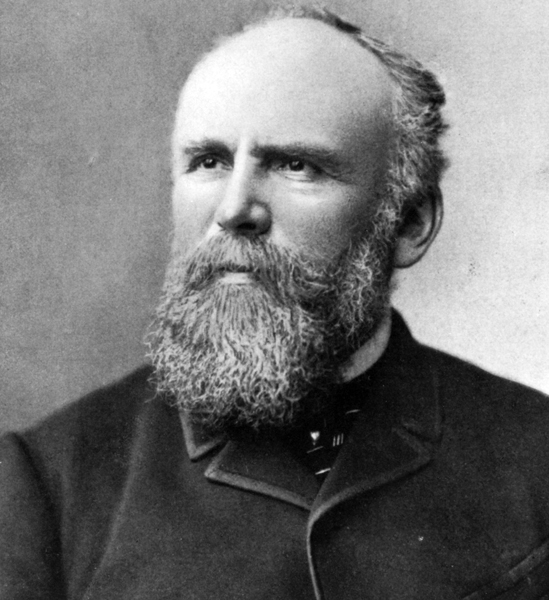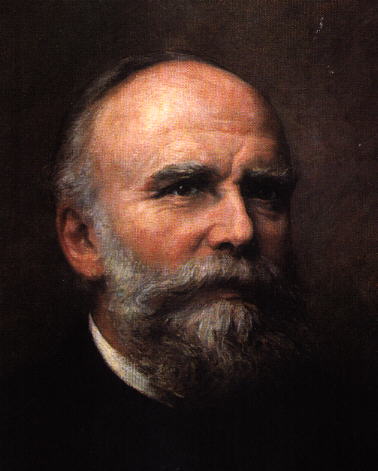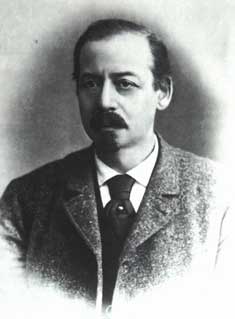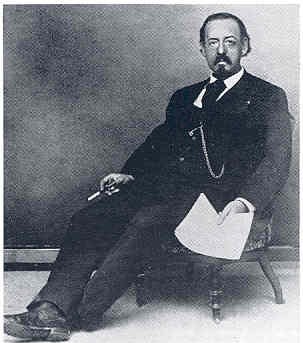<Back to Index>
- Engineer and Inventor Eugen Langen, 1833
- Engineer Pierre Hugon, 1800+
- Inventor Siegfried Samuel Marcus, 1831
PAGE SPONSOR


Eugen Langen (1833 – 1895) was a German entrepreneur, engineer and inventor, involved in the development of the petrol engine and the Wuppertal monorail. In 1857 he worked in his father's sugar factory, JJ Langen & Söhne, after an extensive technical training at the Polytechnic institute in Karlsruhe.
Langen met Nikolaus August Otto in 1864. Otto was working on improvements to the gas engine invented by Belgian Etienne Lenoir. The technically trained Langen recognized the potential of Otto's development, and one month after the meeting, founded the first engine factory in the world, NA Otto & Cie. At the 1867 Paris World Exhibition their improved engine was awarded the Grand Prize.
After this first factory went bankrupt, Langen founded a new company for the construction of gas engines, the Deutz gas engine factory, which later became the group Kloeckner - Humboldt - Deutz (KHD). This became today's Deutz AG. Langen invented and applied new methods of production in the KHD factory.
In the field of rail transport equipment, Langen was co-owner and engineer of the Cologne Waggonfabrik van der Zypen & Charlier. He started the Wuppertal monorail, a suspension railway system, in 1894.
Pierre Hugon is mainly known through his contribution to the early internal combustion engine, especially the "Hugon" engine, which was the second internal combustion engine to go into commercial production - and was a stationary engine along similar lines to the earlier "Lenoir" engine. According to various patents and other entries Pierre Hugon is variously described as a "Civil Engineer", and also as "directeur de la Compagnie du Gaz de Paris". In 1866 the London Gazette informs us that he is resident in Paris at 56 Rue de l'Orient, and in his US patent of 1874 he is still listed as a resident of Paris.
It is clear from the subject matter and date of Pierre Hugon's
patents that he was active in experimenting with early internal
combustion engines even before the first commercial engine was marketed
by Étienne Lenoir.
In his US Patent 41299 he list the deficiencies of current gas engines
as follows : "I have observed in gas engines that the direct action of
the gaseous mixture when exploded to obtain motive power formed a great
difficulty in its application arising from the instantaneousness of the
effect produced." He then goes on to describe an unusual engine in which
the explosion works on water and both positive pressure and vacuum
resulting are used to drive the water and so to move the piston.
Just one year later in US patent 49346, he has returned to more
conventional design but still sought to address the deficiencies of the
current gas engine, this time identified as the spark ignition system
which is blamed for "stoppages of the engine which are incompatible with
the regularity and uniformity of action of motive power necessary for
industrial or manufacturing purposes". This patent records the essential
ideas that are the basis of his commercial engine, the key one being
the use of a modified slide valve to allow a flame to ignite the mixture
rather than a spark. This same principle was patented by William Barnett in 1838, but Barnett used a rotating cock rather than a slide valve
mechanism. The other novel feature is the use of small quantities of
water injected into the cylinder to control temperature.
The commercial Hugon engine appeared in 1865, and in appearance much resembled the Lenoir
engine, but with flame ignition and water spray injection into the
cylinder to control the temperatures. It was manufactured in England by
Fred B. Vallance at the Alicel Works, Bridge Street, Greenwich.
According to an advert in "The Newspaper Press" in 1871, it was
available in Quarter Horse Power £40, Half Horse Power £65, One Horse
Power £85, Two Horse Power £110, and Three Horse Power £130. The
Newspaper Press was an internal journal of the newspaper industry, and
the advent of modern mechanized presses in premises without provision
for steam plant and boilers made a business opportunity for compact
mechanical power.
Dugald Clerk provides a detailed engineering description of the engines of that era, and states that the Hugon engine was a "great improvement" on the Lenoir engine, and the consumption of gas was reduced. However the gas consumption was still far greater than the Otto & Langen engine introduced at the Paris Exhibition of 1867 (which also used flame ignition), which according to Clerk had a gas consumption "less than half that of Lenoir or Hugon". However, these engines were very noisy in operation (examples are regularly run at the Anson Engine Museum).
One surviving Hugon engine is owned by the Science Museum (London) and is currently on display at the Anson Engine Museum, there appear to be no other survivors. It is the same engine described in detail by Clerk,
which was a half horse power engine at that time located at the South
Kensington Museum (first edition of his work was in 1886). Clerk notes
that "The only parts that gave trouble were the bellows pumps
controlling the gas supply to cylinder and igniting ports ; these were
made of rubber, and deteriorating after some use gave trouble by leaking
and occasional bursting. In some of the engines in use they were
replaced with metal pumps and a mixing valve. With these additions the
engine at the Patent Office Museum ran for many years." The Patent
Office Museum was transferred to the South Kensington Museum in 1883.
The surviving Hugon engine lacks the rubber bellows and the drive
mechanism for the gas pumps, which by this account were probably removed
while the engine was relatively new, and still being actively used.


Siegfried Samuel Marcus (18 September 1831 – 1 July 1898) was a German born Austrian inventor and automobile pioneer.
Marcus was born in Malchin in Mecklenburg - Schwerin. He moved to Vienna, the capital of the Austrian Empire, in 1852.
From 1856 to 1898 he worked as a self employed manufacturer of scientific instruments in this city. He developed an interest in electricity and as a lighting technician too. His chief improvements include telegraph systems and ignition devices.
Ca. 1870 he put an internal combustion engine on a simple handcart. This appliance was designed for liquid combustibles and made him the first man propelling a vehicle by means of gasoline. Today, this car is well known as “The first Marcus Car”.
In 1883 a patent for a low voltage ignition of the magneto type was given to Marcus in Germany. This design was used for all further engines and, of course, the famous “Second Marcus Car” of 1888 - 89. It was this ignition in conjunction with the “rotating brush carburettor” that made the “Second Car”'s design very innovative.
In 1887, Marcus started a co-operation with the Moravian company Märky, Bromovsky & Schulz. They offered two stroke and — after the fall of the Otto - Patent in 1886 — four stroke engines of the Marcus type.
In 1888 - 89 Märky, Bromovsky & Schulz built the “Second Marcus Car”, which can still be admired in Vienna's Technical Museum. This car made Marcus well known all over the world. For a long time it was a common understanding that the “Second Car” was already existing in 1875 — even today a widespread falsity. “It was uncertain for a long time whether his car was ready to drive already in 1875 or only in 1888 - 89. Today the later date is considered for sure.” There is not even one single proof for an origin prior to 1888 - 89. This car was named a Historic Mechanical Engineering Landmark by the American Society of Mechanical Engineers.
Marcus was the holder of 131 patents
in 16 countries. He never applied for a patent for the motorcar and, of
course, he never held one. In addition, he never claimed having
invented the motorcar. Nevertheless, he was the first man who used gasoline for propelling a vehicle in the simple handcart of 1870 (First Marcus Car). But it is not sure if the famous Second Marcus Car ever ran before 1890.
Marcus was buried at the Protestant Cemetery at Hütteldorf, Vienna. Later, his remains were transferred to an “Honorary Tomb” of Vienna's Central Cemetery.
Because of Marcus’ Jewish ancestry his name and all memorabilia vanished under the Nazis. The memorial in front of the Vienna Technical University was removed. After the war, the monument was rebuilt. In 1950, the Second Marcus Car has undergone a major restoration.
Marcus was removed from German encyclopedias as the inventor of the modern car, under a directive from the German Ministry for Propaganda during the Second World War. His name was replaced with the names of Daimler and Benz. The directive (in German) read as follows:
Reichsministerium für Volksaufklärung und Propaganda Geschäftszeichen. S 8100/4.7.4.0/7 1
Berlin W8, den 4. Juli 1940 Wilhelmplatz 8-9
An die Direktion der Daimler-Benz-A.G. Stuttgart-Untertürkheim
Betrifft: Eigentlichen Erfinder des Automobils Auf Ihr Schreiben vom 30. Mai 1940 Dr.Wo/Fa.
Das Bibliographische Institut und der Verlag F.A. Brockhaus sind darauf hingewiesen worden, dass in Meyers Konversations Lexikon und im Großen Brockhaus künftig nicht Siegfried Marcus, sondern die beiden deutschen Ingenieure Gottlieb Daimler und Carl Benz als Schöpfer des modernen Kraftwagens zu bezeichnen sind.